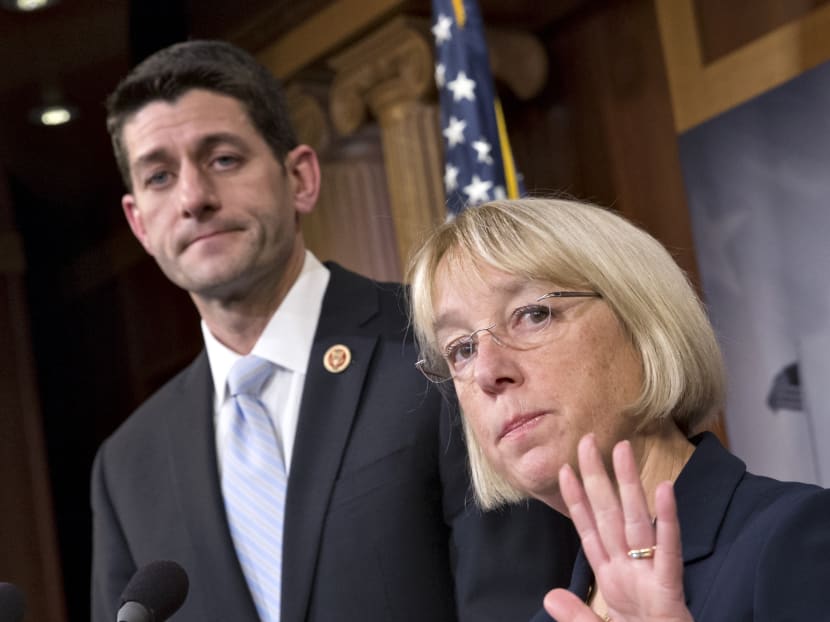US House passes S$1.4 trillion bill to fund government
WASHINGTON — A US$1.1 trillion (S$1.4 trillion) spending bill for operating the United States government until just before next fall’s election steamed through the battle-weary House yesterday (Jan 15) over tepid protests from tea party conservatives, driven by a bipartisan desire to restore painful cuts in domestic and defence programmes and show disaffected voters that Congress can do its job.

House Budget Committee Chairman Rep Paul Ryan (left) listening as Senate Budget Committee Chair Sen Patty Murray announces a tentative agreement between Republican and Democratic negotiators on a government spending plan, on Capitol Hill in Washington on Dec 10, 2013. Photo: Reuters
WASHINGTON — A US$1.1 trillion (S$1.4 trillion) spending bill for operating the United States government until just before next fall’s election steamed through the battle-weary House yesterday (Jan 15) over tepid protests from tea party conservatives, driven by a bipartisan desire to restore painful cuts in domestic and defence programmes and show disaffected voters that Congress can do its job.
The bill swept through the House on a 359 to 67 vote and was on track for a big Senate vote by week’s end. Republicans voted for the bill by a two-and-a-half to one margin, and just three Democrats were opposed.
The measure funds virtually every agency of government and contains compromises on almost every one of its 1,582 pages. It covers the one-third of government spending subject to annual decisions by Congress and the White House, programmes that have absorbed the brunt of budget cuts racked up since Republicans reclaimed control of the House three years ago.
Excluded are the giant benefit programmes like Social Security, Medicare, Medicaid and food stamps that run on autopilot and are increasingly driving the government deeper into debt.
Tea party Republicans, chastened after sparking a 16-day partial shutdown of the government last October in a kamikaze attempt to derail President Obama’s health care law, appeared resigned to the bill.
“I don’t think there’s going to be a lot of opposition,” one tea party leader, Representative Raul Labrador, said before the vote. “The die has been cast for the next year on budget fights.”
To buy time for the Senate debate, Congress yesterday sent US President Barack Obama a three-day funding bill in time to avert a scheduled shutdown at midnight. The Senate cleared that measure by an 86 to 14 vote.
The bill increases core agency spending by US$26 billion over the fiscal 2013 year that began Oct 1, after last year’s automatic spending cuts took them to US$986 billion. But that is US$31 billion less than Congress passed last March before automatic cuts known as sequestration took effect.
The Pentagon faces a tight squeeze even as it avoids what would have been another US$20 billion wave of automatic cuts. The Pentagon’s core budget is basically frozen at US$487 billion after most accounts absorbed an 8 per cent automatic cut last year. Adding US$6 billion to Mr Obama’s war request provides some relief to readiness accounts, however, though active duty troop levels would still be cut by 40,000 to 1.36 million. It includes US$85 billion for overseas military operations, a slight cut from last year.
Domestic programmes generally fare better and are kept, on average, at levels agreed to last year before the automatic cuts of 5 per cent kicked in across the board. Those broadly applied cuts, called sequestration, were triggered by Washington’s inability to follow up a 2011 budget deal with additional deficit savings.
NASA, the FBI and the Border Patrol all won spending increases at the expense of cuts to the Transportation Security Administration, Internal Revenue Service and foreign aid.
The lowest-common-denominator bill doesn’t contain big-ticket wins for either side, but the simple fact that a deal came together was seen as a win for Congress as an institution and its band of 81 appropriators. House Speaker John Boehner, strongly pushed for a deal, even though the end product was a 15cm-high “omnibus” compilation of what was supposed to be a dozen separate spending bills. Presidents and lawmakers alike deride such measures.
The alternatives, however, were to allow automatic spending cuts to strike for a second year and risk another politically debilitating government shutdown.
Democrats celebrated winning an addition US$1 billion over last year for the Head Start early childhood education programme and excluding from the bill a host of conservative policy “riders” advanced by the Republicans.
“We were able to strip out nearly all the new, divisive riders relating to abortion, contraception, gun control, immigration, implementation of the Affordable Care Act, Dodd-Frank, environmental protection,” said Rep Nita Lowey of New York, the top Democrat on the House Appropriations Committee. “This is very important to Democrats.”
Republicans, meanwhile, successfully “zeroed out” funding for high-speed rail, a slap at California Democrats, and they were able to keep tight limits on the implementation of “Obamacare” and the 2010 Dodd-Frank overhaul of financial regulations. AP






